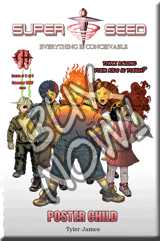 I made it! Several months ago, I committed to writing a ten part series reflecting on my writing process. I was pleasantly surprised to find that a lot of people have found my musings on craft helpful. Over the past few months, I've written about developing the Great Idea, conducting Research to develop that idea and and crafting a Killer Pitch. I've written about ways to write Characters That'll Make You Give a Damn, ways to make your stories Structurally Sound, and how to plot your tales Beat by Beat. I've written my views on what makes Scenes Memorable, listed rules for writing Sharp Dialogue, and given tips for attacking the Re-Write. At this point in the writing process, there's really not a whole lot left to do. You're almost ready to put your baby in the hands of other talent. Let's talk about those finishing touches.
I made it! Several months ago, I committed to writing a ten part series reflecting on my writing process. I was pleasantly surprised to find that a lot of people have found my musings on craft helpful. Over the past few months, I've written about developing the Great Idea, conducting Research to develop that idea and and crafting a Killer Pitch. I've written about ways to write Characters That'll Make You Give a Damn, ways to make your stories Structurally Sound, and how to plot your tales Beat by Beat. I've written my views on what makes Scenes Memorable, listed rules for writing Sharp Dialogue, and given tips for attacking the Re-Write. At this point in the writing process, there's really not a whole lot left to do. You're almost ready to put your baby in the hands of other talent. Let's talk about those finishing touches.X. An Artist Ready Script
A year ago, I didn't have much to say about this topic. Because I've always done all of my own drawing and lettering, I really haven't had much need to share my comic scripts with other people. But, last summer I made the decision to try to work with a few outstanding artists to bring some great new comics to life. Now I wasn't only writing for myself, I was writing for an artist. Because of this, it was important to take my scripts to another level of professionalism and quality. What follows are some suggestions of things you should do prior to sending your scripts off to the artist.
Proofread. Should go without saying, right? Unfortunately, it needs to be said. You're the writer. Proofreading is your job. It's not your artist's job and it's not your letterers job. It's not even your editor's job, if you have one. I'm shocked at how many people posts scripts online on sites like Pencil Jack or Digital Webbing for feedback or for artists to try their hand at sequentials who have God awful errors in spelling, punctuation, sentence structure and syntax. We're talking scripts that aren't even fit for a remedial high school English class. I'm not even including the content here, I'm simply talking about easily corrected errors. I can't count how many times I've looked at scripts online and haven't made it past the first line of the script without coming across a typo. And punctuation? From the looks of many of the scripts online, you'd assume there's a gene common to aspiring comic writers that makes them allergic to commas and periods. I even read one script that was posted online looking for feedback, where the writer said at the top, "Hey, I'm looking for feedback on this script. Don't worry about the spelling or English mistakes. I've got people who will take care of that for me later." Trust me. I didn't worry about it. Because after coming across 15+ easily correctable errors on page 1, I stopped reading.
No, it's your job to do the best you possibly can at proofreading your script before you put it in the hands of your artists. Look at it from the artists perspective. If you're an aspiring writer, you're likely partnering up with an aspiring comic artist. (I'd suggest partnering up with someone a little more seasoned than yourself...they'll make you look good.) Realize that when it's all said and done, they're probably going to put more time into the comic than you have, simply because it takes longer to draw than it does to write. Also remember, most of the time you're going to care about the script a lot more than your artist partner will. It's your baby. It's going to take the artist a while to get invested. So, if the artist gets a script that has typos and easily corrected errors, what's he going to think? Well, either, A.) You're not a great writer. (This is not good. If I'm an artist trying to make a name for myself, I want to partner with the next undiscovered superstar, ala Matt Fraction or Jason Aaron, and not some guy who doesn't know the difference between "there" and "their.") Or B.) You just don't care that much about this script. (Also not good. If the writer doesn't care enough to run his script through spellcheck, why should the artist. So, maybe instead of doing his or her absolute best work, he'll cut corners here and there, leave out little details, fake perspective, etc.)
You want the alternative. You want to send the artist a pristine, engaging, dynamic script that inspires him to do his best possible work. Be professional. Proofread.
Be clear. When you turn your script over to an artist, you are entrusting your vision of the story to another. The only way to ensure that your story is told the way you want to tell it is to be as clear as possible. When you're writing descriptions, you need to describe as best as you can, the precise picture of the panel you have in your head. Who is in the panel? What's the setting? What's the action? Where is the camera positioned? What is the focal point? The more of these details you include, the more likely it is that your artist will deliver.
Remember, with a rich and detailed descriptions, a strong artist can deliver the picture you have in your head. The more details you leave out, the more you'll get the picture in the artist's head.
Provide reference. Drawing comics is time consuming work. Think about it. Brian Michael Bendis can write five different comic books a month. How many can Bryan Hitch draw? Ten a year, maybe? Because penciling and inking is so time consuming, as a writer, you want to make things as easy as possible for the talent you're working with. You want them spending most of their time drawing. But, it you write in your script something like, "The sky is filled with a squadron of World War II-era planes," and leave it at that, what's the artist going to do? Most likely, he's going to spend time Googling old warplanes. Think about it? Do you want your artist Googling, or do you want him drawing?
Since you've done research anyway, (and if you haven't, here is why you should) providing links in your script or creating a shared online photo album with potentially helpful images should be easy. Cut your artist some slack and do some of this work for him. You may also find that a lot of the same reference material that inspires your writing on a particular project will help inspire the artist, too.
On ICE: Interrogation Control Element, for example, I wrote this in the script I sent to Damian Couceiro:
Panel 1- Full black panel, save a stream of water pouring down the center of the panel.
CAP (TRIP)- There are sixteen authorized interrogation methods consistent with the Geneva Conventions.
Panel 2- Close in on the face of Iraqi prisoner Number 240, HESHAM FARUK. He is strapped down on a table, with a blindfold over his eyes. There is a strap around his forehead, which is attached to the board he's lying on. The stream of water is filling up in his mouth and he is clearly in panic and pain. He's being waterboarded.
CAP (TRIP)- This is not one of them.
REFERENCE NOTE: This opening approach was inspired by this short clip. Watch for great reference. http://www.guardian.co.uk/media/2008/apr/22/advertising.humanrights
Sketch a layout. Sometimes when writing comics, you're going to ask a lot of an artist. Maybe there's a particularly tricky action sequence that just has to be done right. Maybe there's a page with a heavy amount of dialogue, and every word truly matters. Rather than fire that page off to your artist and hope for the best, it's a good idea to try to layout the page yourself first.
Sure, easy for me to say. I've drawn a couple hundred pages of comics in my lifetime. So it should be no problem to layout a page, right? When I'm telling you to layout a page, I'm not asking for a beautifully rendered piece of art. Anyone can draw rectangular panels and stick figures. Below is a page from one of Jeph Loeb's scripts for Batman: The Long Halloween. You'll see Jeph did a quick and dirty layout for his artist, Tim Sale.

By taking a stab at laying out a page, you will better be able to answer questions: Will it all fit on the page? Will these panels have impact? What's the most important panel on the page? Where are my word balloons going to go? You want to have confidence that the script you send your artist will work as written. Doing some quick layouts is one way to get that confidence.
Do these things, and you're ready. Once you've proofread your work and are sure it would pass muster in English class, once you've been as clear as you need to be, once you've provided reference where helpful, and once you are confident the pages will work as written by sketching or laying out your page quickly yourself, you're ready to turn your work over to an artist. Congrats!
And now things get fun. You get to take off your writer's hat, and put on your producers hat, to shepherd the project from written page to finished comic. This brings up it's own set of challenges, and is outside the scope of this article series. But trust me, once those pages start showing up in your email box, all the work you've put into writing suddenly becomes so worth it.
Alright, that's it for this series on writing process. Thanks for reading. My enjoyment for writing this series and the fact that others have found it beneficial has lead to an exciting new opportunity. In a few weeks, I'll be starting up a weekly column titled "Creating Comics! The Art & Craft" which will run on the popular comic news site Comic Related. There I'll be expanding on the topics I've been talking about in this series, and hopefully bringing some tools, perspective and a whole lot of inspiration to a wider audience. I'll be talking more about that series as it gets closer to launching next month. Hope you'll join me there.











1 comment:
great series, really enjoyable read.
Post a Comment